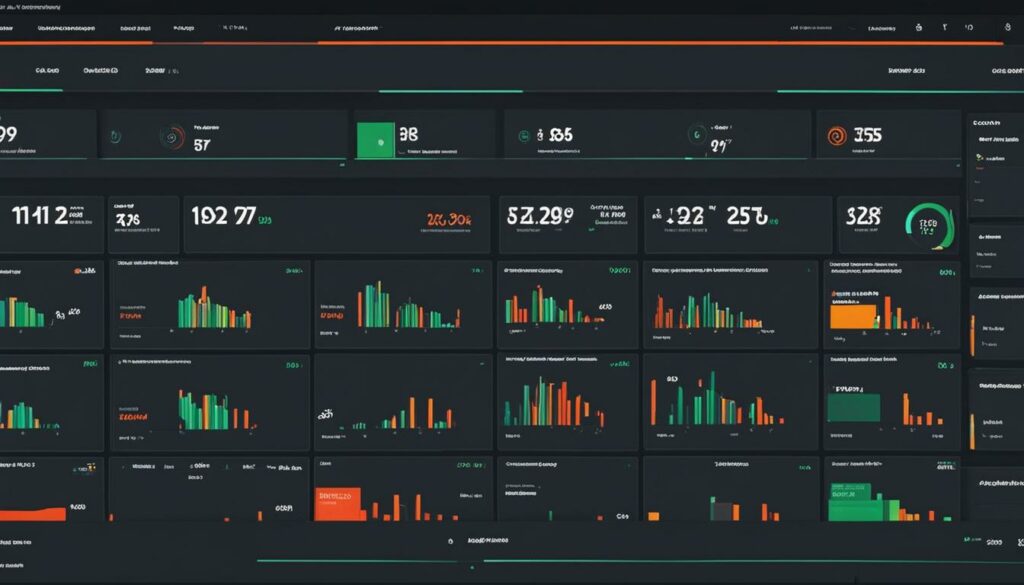Ecommerce inventory management is an organized approach to sourcing, storing, tracking, and shipping an ecommerce business’s inventory. It involves preparing ecommerce inventory, managing inventory, and reporting on inventory metrics. Effective inventory management is crucial for ecommerce companies looking to increase efficiency, reduce operational costs, and meet customer demand. Inventory financing and inventory forecasting are important aspects of inventory management in ecommerce.
Key Takeaways
- Inventory management is an essential aspect of ecommerce operations.
- Effective inventory management can increase efficiency and reduce costs.
- Inventory financing and forecasting are important components of inventory management.
- Proper inventory management ensures meeting customer demand.
- Inventory management plays a key role in the success of ecommerce businesses.
The Importance of Inventory in Ecommerce
Effective inventory management is crucial for the success of ecommerce businesses. By optimizing inventory levels and implementing best practices, businesses can achieve financial efficiency, meet customer demand, and improve overall operations.
- Financial Efficiency: Managing inventory allows businesses to optimize stock levels, minimizing holding costs and maximizing financial resources allocation.
- Prompt Order Fulfillment: By ensuring inventory availability, businesses can meet customer demand promptly, avoiding lost sales opportunities and maintaining customer satisfaction.
- Risk Reduction: Effective inventory management prevents overstocking, minimizing the risk of obsolescence and associated costs.
- Improved Cash Flow: By efficiently allocating resources, businesses can optimize cash flow and reduce the need for excess inventory.
- Competitive Advantage: Proper inventory management enables businesses to fulfill orders promptly, leading to customer satisfaction, repeat business, and a competitive edge.
“Inventory management is not just about having the right products in stock; it’s about ensuring that you have the right products at the right time.”
To successfully manage inventory in ecommerce, businesses should implement best practices, including:
- Regular stock counts to ensure accuracy and identify discrepancies.
- Safety stock monitoring to account for unexpected spikes in demand or supply chain disruptions.
- Setting automated reorder points to trigger replenishment orders.
- Minimizing human errors through proper training and the use of technology.
By prioritizing inventory management and following these best practices, ecommerce businesses can optimize operations, improve customer satisfaction, and drive overall success.
| Benefits of Effective Inventory Management | Challenges of Poor Inventory Management |
|---|---|
|
|
Strategies to Improve Ecommerce Inventory Management
Implementing effective strategies can significantly enhance ecommerce inventory management, ensuring efficient operations and customer satisfaction. By incorporating ecommerce inventory management software, utilizing inventory tracking systems, and automating processes, businesses can streamline their inventory management practices.
One of the key strategies to consider is the implementation of ecommerce inventory management software. This software provides a centralized platform for tracking inventory levels, orders, sales, and shipments across various channels and locations. With real-time updates and analytics, businesses can make informed decisions regarding replenishment, pricing, and order fulfillment. This software also enables seamless integration with other systems, such as accounting and customer relationship management (CRM), for comprehensive inventory management.
An additional strategy to improve ecommerce inventory management is the utilization of inventory tracking systems. These systems enable businesses to monitor real-time inventory levels and locations across multiple stores. By having a centralized view of inventory data, businesses can ensure accurate inventory control, reduce stockouts, and avoid overstocking. This strategy is particularly beneficial for ecommerce businesses with multiple warehouses or retail locations.
To further streamline the inventory management process and reduce human error, utilizing barcode scanners and wireless inventory scanners can be highly effective. These tools automate data entry and inventory updates, minimizing the risk of errors associated with manual processes. By scanning barcodes and capturing real-time inventory information, businesses can improve accuracy, save time, and enhance overall inventory management efficiency.
Benefits of Implementing Inventory Management Strategies:
- Improved efficiency in inventory management processes
- Increased accuracy in inventory tracking and control
- Enhanced customer satisfaction through prompt order fulfillment
- Optimized resource allocation and cost-effectiveness
- Reduced human errors and improved data integrity
By implementing these strategies, ecommerce businesses can optimize their inventory management practices, leading to improved efficiency, accuracy, and cost-effectiveness.
| Strategy | Benefits |
|---|---|
| Implementing ecommerce inventory management software |
|
| Utilizing inventory tracking systems |
|
| Using barcode scanners and wireless inventory scanners |
|
Understanding Customer Behavior in Ecommerce Inventory Management
Understanding customer behavior is a critical aspect of effective ecommerce inventory management. By analyzing historical sales data, trends, and seasonal demand, businesses can gain valuable insights into customer preferences and optimize their inventory strategies accordingly. This not only helps prevent stock-outs and overstocking but also maximizes sales opportunities and customer satisfaction. Utilizing advanced ecommerce inventory management software enables businesses to track and monitor customer behavior more efficiently and make data-driven decisions to optimize inventory levels and assortment.
When it comes to ecommerce inventory tracking, customer behavior plays a significant role in determining inventory needs. By understanding customer preferences and purchasing patterns, businesses can align their inventory management strategies with customer demand and ensure timely order fulfillment. Additionally, analyzing customer behavior helps businesses identify trends, such as popular product categories or seasonal buying patterns, allowing them to adjust their inventory levels and assortment accordingly.
The Benefits of Understanding Customer Behavior in Ecommerce Inventory Management
- Accurate Inventory Forecasts: By analyzing customer behavior, businesses can make accurate inventory forecasts based on historical data, trends, and demand patterns. This helps prevent inventory shortages and ensures optimal stock levels to meet customer demand.
- Optimized Inventory Levels: Understanding customer behavior allows businesses to tailor their inventory management strategies and offerings to match customer preferences. By stocking the right products and quantities, businesses can minimize excess inventory and reduce carrying costs.
- Enhanced Customer Satisfaction: By analyzing customer behavior, businesses can identify and respond to customer preferences more effectively. This leads to better product availability, improved order fulfillment, and increased customer satisfaction.
- Increased Sales and Revenue: By aligning inventory levels with customer demand, businesses can maximize sales opportunities and revenue generation. Understanding customer behavior helps identify upselling and cross-selling opportunities, leading to increased average order values.
“Understanding customer behavior allows businesses to tailor their inventory management strategies and offerings to match customer preferences.”
To gain deeper insights into customer behavior, businesses can utilize ecommerce inventory management software. This software provides features such as customer segmentation, purchase history analysis, and predictive analytics, allowing businesses to better understand their customers and optimize their inventory management strategies.

| Benefits of Understanding Customer Behavior in Ecommerce Inventory Management: |
|---|
| Accurate inventory forecasts |
| Optimized inventory levels |
| Enhanced customer satisfaction |
| Increased sales and revenue |
The Relationship between Inventory and Other Ecommerce Metrics
Inventory management is a critical component of ecommerce operations, with a direct impact on various metrics that determine the success of your business. By effectively managing your inventory, you can significantly improve metrics such as order fulfillment rate, customer satisfaction, cash flow, and profitability.
One of the key benefits of proper inventory management is ensuring that orders can be fulfilled promptly. By maintaining optimal inventory levels and having a streamlined replenishment process in place, you can minimize order processing time and increase your order fulfillment rate. This, in turn, leads to higher customer satisfaction as customers receive their products in a timely manner.
Efficient inventory management also plays a vital role in optimizing cash flow. Excess inventory ties up valuable resources and incurs additional holding costs. By accurately forecasting demand and maintaining lean inventory levels, you can reduce excess inventory and allocate your resources more effectively. This allows you to improve cash flow by minimizing unnecessary expenses.
Furthermore, having the right inventory levels helps in avoiding stockouts. Insufficient inventory can result in missed sales opportunities and dissatisfied customers. By closely monitoring customer demand and implementing effective inventory management strategies, you can minimize the risk of stockouts and ensure that popular products are always available for purchase.
Finally, proper inventory management contributes to increased profitability. By minimizing carrying costs associated with excess inventory and avoiding stockouts, you can optimize your inventory investment. This helps in maximizing profitability by reducing unnecessary expenses and lost sales opportunities.

Implementing a robust ecommerce inventory system can provide you with real-time insights into inventory levels, sales data, and customer behavior. This enables you to make data-driven decisions and optimize your inventory management practices for improved performance across various ecommerce metrics.
Challenges and Considerations in Ecommerce Inventory Management
Ecommerce inventory management poses unique challenges for businesses operating in the online retail space. To ensure sustained growth and operational efficiency, it is crucial for ecommerce businesses to address these challenges effectively. From accurate demand forecasting to managing multiple sales channels, here are some of the key considerations and best practices in ecommerce inventory management:
1. Accurate Demand Forecasting
Forecasting customer demand is essential to maintain optimal inventory levels and prevent stockouts or overstocking. By analyzing historical data, sales trends, and seasonal patterns, businesses can make informed decisions about inventory allocation and replenishment.
2. Managing Multiple Sales Channels
In the era of omnichannel retail, managing inventory across various sales channels (e.g., website, marketplaces, physical stores) can be challenging. A centralized inventory management system that integrates with multiple platforms and syncs inventory levels in real-time can streamline operations and prevent overselling.
3. Handling Seasonality
Many ecommerce businesses experience fluctuations in demand due to seasonal trends or promotional events. It is essential to anticipate these seasonal changes and adjust inventory levels accordingly to avoid stockouts during peak periods or excess inventory during slow seasons.
4. Preventing Stockouts and Overstocking
Stockouts and overstocking can have severe consequences for ecommerce businesses. Implementing automated reorder points, utilizing safety stock, and regularly monitoring inventory levels can help optimize stock replenishment and avoid both stockouts and overstocking.
5. Avoiding Human Errors
Manual inventory management processes are prone to human error, which can lead to discrepancies in stock levels, fulfillment errors, and miscommunication. Utilizing inventory management software with barcode scanning capabilities can minimize human errors and improve overall accuracy in inventory tracking and management.
6. Considering Lead Times, Supplier Relationships, and Product Shelf Life
Managing inventory effectively requires considering factors such as lead times from suppliers, maintaining strong relationships with suppliers for timely replenishment, and accounting for product shelf life to prevent wastage or obsolescence.
7. Warehouse Space Limitations
Physical space constraints in warehouses can present challenges in storing and organizing inventory. Optimal warehouse layout design, utilizing vertical space, implementing efficient storage systems, and investing in warehouse management software can help maximize space utilization and streamline operations.
In summary, managing inventory in ecommerce requires addressing various challenges and considerations to ensure smooth operations and optimize customer satisfaction. By implementing best practices, leveraging technology solutions, and staying updated on industry trends, ecommerce businesses can enhance their inventory management processes and drive sustained growth.

| Challenges | Considerations |
|---|---|
| 1. Accurate demand forecasting | 1. Analyze historical data and sales trends |
| 2. Managing multiple sales channels | 2. Implement a centralized inventory management system |
| 3. Handling seasonality | 3. Anticipate seasonal changes and adjust inventory levels accordingly |
| 4. Preventing stockouts and overstocking | 4. Utilize automated reorder points and safety stock |
| 5. Avoiding human errors | 5. Utilize inventory management software with barcode scanning |
| 6. Considering lead times, supplier relationships, and product shelf life | 6. Account for lead times, maintain strong relationships with suppliers |
| 7. Warehouse space limitations | 7. Optimize warehouse layout design and invest in warehouse management software |
Conclusion
Effective inventory management plays a crucial role in the success of any ecommerce business. By ensuring that products are readily available to meet customer demand, businesses can optimize financial efficiency and improve overall operations. Implementing strategies such as inventory management software, tracking customer behavior, and considering the relationship between inventory and other ecommerce metrics can significantly enhance inventory management practices.
However, accurate demand forecasting and managing multiple sales channels pose challenges that require careful navigation. By adopting best practices, staying proactive, and leveraging the power of technology, ecommerce businesses can overcome these hurdles and achieve greater efficiency, customer satisfaction, and profitability.
With the ever-growing competition in the ecommerce industry, effective inventory management is not just a choice but a necessity. By prioritizing inventory management and investing in the right tools and strategies, businesses can ensure that they have the right products in the right place at the right time. This not only improves customer experience but also minimizes holding costs, avoids stockouts, and maximizes sales opportunities.
In conclusion, ecommerce inventory management is the backbone of a successful online business. It not only drives operational efficiency but also impacts key metrics such as customer satisfaction, cash flow, and profitability. By recognizing the importance of inventory in ecommerce and implementing effective inventory management practices, businesses can thrive in this competitive landscape and achieve sustainable growth.
FAQ
What is inventory in ecommerce?
Inventory in ecommerce refers to the goods and products that an ecommerce business holds in stock to sell to customers. It includes raw materials, finished goods, and products in various stages of production.
Why is inventory management important for ecommerce?
Inventory management is crucial for ecommerce businesses as it helps increase efficiency, reduce operational costs, and meet customer demand. It optimizes inventory levels, ensures timely order fulfillment, and improves cash flow.
How can I improve my ecommerce inventory management?
Strategies to improve ecommerce inventory management include implementing inventory management software, using inventory tracking systems, and analyzing customer behavior and preferences. These practices can enhance efficiency, accuracy, and cost-effectiveness.
How does customer behavior impact ecommerce inventory management?
Understanding customer behavior helps ecommerce businesses make accurate inventory forecasts and plan for customer demand. By tracking preferences and buying patterns, businesses can tailor their inventory management strategies to increase customer satisfaction and loyalty.
What is the relationship between inventory and other ecommerce metrics?
Inventory management affects metrics such as order fulfillment rate, customer satisfaction, cash flow, and profitability. Proper inventory management ensures prompt order fulfillment, improves cash flow, and minimizes carrying costs and stockouts.
What are the challenges in ecommerce inventory management?
Challenges in ecommerce inventory management include accurate demand forecasting, managing multiple sales channels, handling seasonality, preventing overstocking or stockouts, and avoiding human errors. Lead times, supplier relationships, and warehouse space limitations must also be considered.
What is the conclusion of ecommerce inventory management?
Effective inventory management is crucial for the success of ecommerce businesses. It ensures product availability, optimizes financial efficiency, and improves overall operations. By implementing best practices and staying proactive, businesses can achieve efficiency, customer satisfaction, and profitability.
